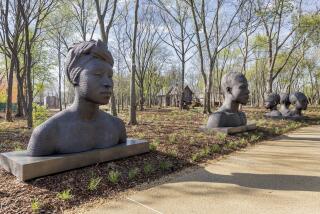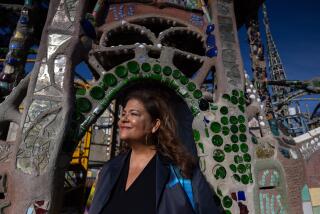Ladies Who Languish in a Basement
WASHINGTON â At last, Ladies-in-the-Bathtub seemed headed for higher ground.
A 1921 sculpture of three suffragettes, torsos rising stoically out of a block of Italian marble, would languish no longer in the basement of the U.S. Capitol but be moved to the main floor as a celebration of women.
A resolution to hoist the carved features of Elizabeth Cady Stanton, Susan B. Anthony and a bonneted Lucretia Mott breezed through the Senate last summer to mark the 75th anniversary of womenâs right to vote.
Then it reached the House floor, where two GOP women rose to object that taxpayer funds could be better spent.
âI hear it is only a few hundred thousand dollars,â U.S. Rep. Linda Smith, of Washington state, argued from the floor. âBut a few thousands and a few millions and a few billions and this nation is in deep, deep trouble.â
As the year of the suffrage anniversary came and went, groups such as the National Federation of Republican Women and the League of Women Voters grew impatient demanding action. House Speaker Newt Gingrichâs answer was to let women decide--a core group of 17 House GOP women.
âSomehow this was sort of dumped in our laps and we were asked to agree [with the Senate vote],â says Connecticut Rep. Nancy L. Johnson. âWe just donât agree with it, thatâs all.â
So much for sisterhood.
Objections to moving the Ladies were myriad. But there was an answer for every concern.
Should a cash-strapped federal government spend money frivolously? The Architect of the Capitol had $400,000 set aside for just such projects.
A poor use of taxpayer money at any cost? The Capitol Preservation Commission, another funding source, has $28 million in privately raised cash.
Too expensive a project regardless? Contractors would donate labor to keep costs well under an estimated $75,000.
Too heavy at 13 tons for the Rotunda? A lightweight steel base would help the statue meet standards.
Still, the GOP congresswomen showed little resolve to act.
âEvery member is terribly busy,â Johnson says. âWhenever the subject would come up, the crowd would disperse.â
The inertia left Sen. John W. Warner (R.-Va.) fuming. He sponsored the Senate resolution that passed overwhelmingly last year. âIâm somewhat disappointed that the outside world has to look at a Congress that cannot seem to get its thoughts together on this,â Warner says. âI mean, itâs a very straightforward issue.â
House Democrats, including Jane Harman of Rolling Hills, just shake their heads. âI find that itâs an apt metaphor for gridlock and, sadly, the erosion of womenâs rights,â she says. âI say, letâs get on with [moving the statue] and stop fussing.â
To help light a fire under the GOP House women, the Woman Suffrage Statue Campaign was formed in February, drawing support from an expanding circle of women and political organizations like the Business and Professional Women, the American Assn. of University Women and both national political parties. In March, the campaign began a fund drive to jump-start movement on the statue, raising $17,000 from individual contributions; itâs planning a major reception this summer.
When the Democratic National Committee put a plea on its World Wide Web site for moving the statue, the Republican National Committee, already worried about a growing gender gap nationwide, followed suit with its own Web page.
But nothing has budged the core group of GOP House women.
âWhere are we now? Iâm really not sure,â sighs Rep. Constance A. Morella (R-Md.), who has pushed her colleagues hard to salvage the suffragettes. âI donât think too many of the women are that interested in it. They just donât like that statue.â
*
And therein lies the rub.
Kibitzing over feasibility and cost aside, Johnson and others simply donât like the look of the Ladies.
âItâs very heavy. Itâs very square. It takes up a lot of space. And unless youâre tall enough,â says Johnson, who barely clears 5 feet, âyou really donât get the full impact. That statue needs to be near a circular stair.â
âI love it. I think itâs beautiful,â says Karen Staser, co-chairwoman of the Woman Suffrage Statue Campaign. â[The artist] put these women in this solid rock of marble to symbolize women rising up . . . out of oppression.â
Suddenly, everybodyâs an art critic.
Johnson is leading an effort for a substitute to be placed in the Rotunda, this one of Esther Hobart Morris, who helped make Wyoming the first state or territory to grant women the right to vote in 1869. The life-size statue of Hobart, caught in mid- and purposeful stride, gown flowing dramatically, now stands in a hallway just outside the Rotunda.
âShe is not only female, but she is forceful. She is moving. . . . She is powerful,â says Johnson, who has been planning to meet with womenâs groups to discuss her idea. But she hasnât yet had a chance.
Others say that relying on some individual standard for aesthetic beauty misses the point.
âItâs kind of ridiculous when you think about it,â says Warner staff aide Sherry Little, who has been shepherding the Stanton-Anthony-Mott statue resolution. âNobody decides whether or not Abraham Lincolnâs contributions are relevant based on what he looks like. This is the way these [three] women looked. They werenât all dolled up in high heels and bustiers. They got all those rings under their eyes and worry lines and frowns and half-bald heads from giving speeches all over the country, from organizing.â
And the symbolism, she and others say, extends beyond the accomplishments of the three women in organizing and leading women suffrage. They point to the statueâs history. Presented to an all-male Congress by the National Womanâs Party in 1921, it was accepted grudgingly with the inscription that praised the three women âwhose spiritual import and historical significance transcend that of all others of any country or any age.â
The gilt inscription, believed too aggrandizing of women, was whitewashed and the statue was placed in storage beneath the Rotunda in an area called the Crypt.
It was brought out of storage when the Crypt was renovated into a display area in 1963. Three past congressional efforts to place the Ladies in the Rotunda, where women originally intended it to go, failed.
The Rotunda, symbolic and physical center of the Capitol with its 180-foot-high domed ceiling, now has 11 statues on display.
All honor men.
More to Read
The biggest entertainment stories
Get our big stories about Hollywood, film, television, music, arts, culture and more right in your inbox as soon as they publish.
You may occasionally receive promotional content from the Los Angeles Times.










